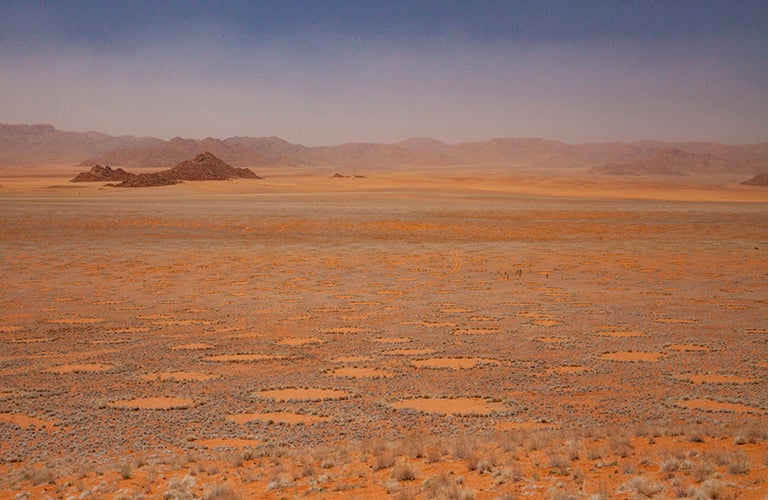Mathematics of Planet Earth: Math Profs create symposium at AAAS conference

February 13, 2018 — Professors Hans Kaper and Hans Engler of the Department of Mathematics and Statistics have organized a symposium “Mathematics of Planet Earth: Superbugs, Storm Surges, and Ecosystem Change,” for the Mathematics Section of the American Association for the Advancement of Science (AAAS) at its annual meeting in Austin, Texas, next week.
ADDRESSING A BROAD AUDIENCE
The AAAS Annual Meeting is the nation’s largest general science assembly, drawing a broad spectrum of researchers — “from astronomy to sociology,” according to Engler — and a significant media presence. The meeting is held every year and features plenary lectures, poster sessions, and approximately 150 topical 90-minute symposia.
Given the diverse interests of the audience, mathematics is usually presented through its applications. “People tend to think that nothing new in mathematics has happened since 1900, and that’s not the case,” Kaper said. “Mathematics is alive and well and finding more and more applications.” This year’s symposium theme chosen by the organizers is Mathematics of Planet Earth (MPE).
The symposium features Clint Dawson of the University of Texas at Austin, Corina Tarnita of Princeton University, and Glenn Webb of Vanderbilt University. Each of the speakers will highlight how mathematical modeling can be used to predict climate events and environmental behavior.
SUPERBUGS, STORM SURGES, AND ECOSYSTEM CHANGE
Dawson uses mathematical models to predict how storm surges and rainfall will impact coastal land areas. His research helps coastal communities, like nearby Houston, better prepare for dangerous storms.
“These computational models are detailed enough to give you many scenarios of how a certain area could be overwhelmed with floodwaters, or whether a sea wall would protect an area,” Engler said. “You can’t do a laboratory experiment for a hurricane, but you can do a computer simulation.”
Tarnita researches vegetation patterns, focusing on dry ecological systems like savannahs and shrublands. Her models can be used to predict rapid changes in vegetation that indicate a potential shift to a desert climate.
“You can tweak the model and see what happens in response to changes in rainfall patterns over the next few decades — if they increase, decrease, or the frequency or seasonality changes, all of which could happen with climate change,” Engler said. “How will this affect the vegetation patterns?”
Webb’s models track the spread of infectious diseases through communities, focusing on the spread of the Zika virus — in both Rio de Janeiro and Houston — as well as influenza outbreaks.
“It’s looking at a spatial community,” Engler said. “[Webb] is modeling how Zika might start in one corner of one town and the way it spreads via mosquitoes, for example.”
CLIMATE MATH PIONEERS
While Kaper and Engler aren’t presenting themselves, they are no strangers to leadership roles in the field of climate mathematics.
After a distinguished career spent working in applied mathematics at Argonne National Laboratory and the National Science Foundation, Kaper joined the Georgetown faculty in 2008. He and Engler, a longtime Georgetown mathematics professor, soon began to explore climate mathematics.
“Climate is among the most important issues we face, and you don’t hear enough about it,” Kaper said. “It will affect our lives — if not my generation, certainly the younger generations.”
Shortly after leaving the NSF, Kaper helped found the Mathematics and Climate Research Network (MCRN), a group of 12 research teams from across the US with an international membership of well over 200, to create a community of mathematicians and geoscientists to study climate issues.
“It was a virtual community of people who didn’t know each other, who got together and used modern web communication tools, with occasional face-to-face meetings, to address mathematical issues related to climate,” Engler said.
Inspired by the MCRN, Kaper and Engler sought to bring a climate mathematics course to the Hilltop. Upon discovering a dearth of good literature, they published a textbook, Mathematics and Climate, which was published in 2014 by the Society for Industrial and Applied Mathematics (SIAM). They see climate mathematics as an exciting opportunity for classroom experience, due in part to the frequent tie-ins to real world events.
“This is an area where current events just constantly pop up,” Engler said. “It makes it very rewarding to teach.”
Kaper is Founding Chair and Engler the current Chair of the SIAM Activity Group on MPE.
- Tagged
- Events
- Faculty
- Mathematics